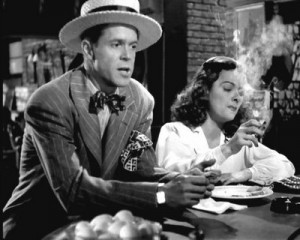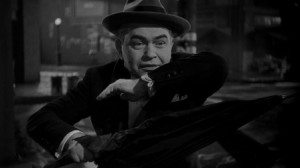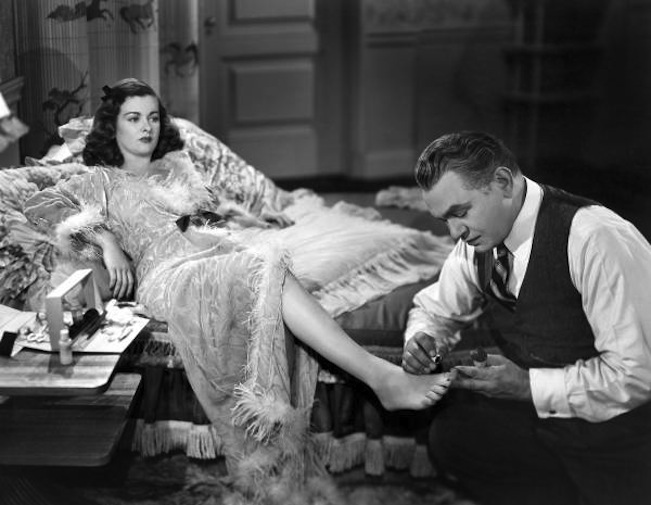

By Mike Wilmington Wilmington@moviecitynews.com
Wilmington on DVDs: Scarlet Street
Pick of the Week: Classic
Scarlet Street (Blu-ray) (Four Stars)
U.S.; Fritz Lang, 1945 (Kino Video).
1. Fritz Lang and Scarlet Street
Scarlet Street — a great Golden Age movie that takes us to the lower depths of a lost soul in Greenwich Village — is generally regarded as one of the classic film noirs, as well as director Fritz Lang‘s highest Hollywood achievement. It is.
Adapted from another film classic, Jean Renoir‘s lively and perverse 1931 French crime movie La Chienne, Lang’s vintage noir has one of the unforgettable Golden Age screen triangles: Joan Bennett as a classically slutty femme fatale, Dan Duryea as her pricelessly sleazy pimp-lover, and Edward G. Robinson solid as a volcano as Chris Cross, a part based on Michel Simon’s old role, in La Chienne, of the henpecked husband cashier/painter who stumbles, out of love and lust, into the dark side. They’re reputed to be one of the best noir threesomes. They are.
Scarlet Street was made in the high noir year of 1945 and it has a top pedigree behind the camera. There was Lang himself — maker of the darkly magnificent German epics and crime thrillers Metropolis, Die Nibelungen, Spies, the Dr. Mabuse films, and the American drime and war classics Fury, You Only Live Once and Hangmen Also Die, and the all time crime movie masterpiece M.
It was produced by Lang together with (uncredited) Bennett’s husband Walter Wanger (Invasion of the Body Snatchers), scripted by Dudley Nichols (The Informer, Stagecoach), photographed by Milton Krasner (The Set-Up), art-directed by Alexander Golitzen (Hitchcock’s Foreign Correspondent), and based, like Renoir’s picture, on the novel and play by Georges de La Fouchardiere and Andre Mouezy-Eon. It’s a compelling tale of exploitation, adultery and murder: a nightmare that sings.
The movie is set in that little Manhattan sub-island of art and politics and sin, Greenwich Village, in 1934. (The look though, is pure ‘40s.) At a convivial, well-liquored employee party for a local bank, Chris Cross (Robinson), trusted cashier, is about to receive the standard gift for “25 years of faithful service” from his suave, silver-haired boss J. J. Hogarth (Russell Hicks) — a gold watch, with inscription — right before J. J., who’s as old or older than Chris, rushes off for a hot limousine date with an adoring blonde bombshell, admiringly spied on from above by his employees. “I wonder what it would be like to be loved by a young girl like that,” Chris muses to a work friend as they stroll toward the subway. Fate answers him almost immediately.
Across the dark, wet, shiny street of one of those memorable film noir night-city sets (done by three-time Oscar-winner Golitzen, one of whose awards was for To Kill a Mockingbird), the beautiful young Katherine “Kitty” March is being beaten and kicked, even as she lies on the sidewalk, by the decidedly-less-than-gallant Johnny Prince (Duryea, in one of his expertly nasty villain performances). Chris rushes to her aid, beats off the decidedly-less-than-brave Johnny with his umbrella, and walks Katherine home, then invites her for a coffee. Kitty is not too bright a conversationalist, but she has soft dark eyes, Hedy Lamarr hair and a big bosom, and she knows men. Chris is quickly smitten — love-happy enough to rent Katherine an apartment where she can live and he can paint (his life-long Sunday hobby), paid for partly by money he starts to pilfer from the bank accounts.
 What Chris doesn’t realize is that Kitty is a professional whore, Johnny is her pimp, and Johnny isn’t shy about fleecing him for everything he’s got — especially since Chris has lied and told Kitty he was a wealthy artist. Furthermore, despite the physical abuse, she’s crazy about that slimy streetwise cur Johnny: “Jeepers, I love you Johnny,” she likes to tell him, while he calls her “Lazy Legs.“ And Johnny’s regular appearances at the apartment, in full smirk — sometimes with Kitty’s embittered fashion model girlfriend Millie (played by a slightly masculine-acting Margaret Lindsay) — greatly disturb Chris, who can’t quite recognize Kitty’s nocturnal assailant in the grinning high-pants glad-hander Johnny who keeps popping up at Kitty’s like a thousand bad pennies.
What Chris doesn’t realize is that Kitty is a professional whore, Johnny is her pimp, and Johnny isn’t shy about fleecing him for everything he’s got — especially since Chris has lied and told Kitty he was a wealthy artist. Furthermore, despite the physical abuse, she’s crazy about that slimy streetwise cur Johnny: “Jeepers, I love you Johnny,” she likes to tell him, while he calls her “Lazy Legs.“ And Johnny’s regular appearances at the apartment, in full smirk — sometimes with Kitty’s embittered fashion model girlfriend Millie (played by a slightly masculine-acting Margaret Lindsay) — greatly disturb Chris, who can’t quite recognize Kitty’s nocturnal assailant in the grinning high-pants glad-hander Johnny who keeps popping up at Kitty’s like a thousand bad pennies.
Meanwhile, Chris’ home life is a hell of bullying and verbal abuse from his harridan wife Adele (the perfectly cast Rosalind Ivan), who keeps carping about the smell of paint (before Chris gets his studio), and ceaselessly singing the praises of her late husband, a real man (as opposed to Chris, who’s often either painting or in an apron), “Patch-Eye” Higgins, played by that excellent porcine character actor, Charles Kemper (The Southerner, Wagon Master, On Dangerous Ground).
But things change, strangely enough, even though the same plaintive big band ballad, “:Melancholy Baby,” keeps echoing and re-echoing on the sound track, like an anthem of the sentimental inner life Chris can’t expose. and that may doom him.
Through some only slightly outrageous coincidences, Chris‘s somewhat Frida Kahlo-like paintings are shown by Greenwich Village sidewalk painter Pop le Jon (Vladimir Sokoloff, the evil landlord of Renoir’s The Lower Depths) and spotted by pretentious big-time art critic David Janeway (Jess Barker). Since Johnny — who was trying to peddle the paintings for walking-around money — has falsely attributed them to Kitty and gotten her to sign them, and since, when Janeway meets Katherine to check out her other work, she has the same soft dark eyes and Hedy Lamarr hair that struck Chris, and Janeway has the same reaction, Kitty, in a way, is set to become the media pet painter. the Jean-Michel Basquiat, if not the Andy Warhol, of her day.
Oddly enough, Chris doesn‘t seem to mind the subterfuge and the theft of his work — partly because he doesn’t believe that his paintings, if the art experts had seen the real painter as he really was, would have aroused the same response. (He‘s probably right, even though tastemaker Janeway first became enthusiastic after seeing the paintings by themselves.) Chris is happy, because he thinks he’s found out what it’s like to be loved by a young girl, what it’s like to be admired and maybe even adored — and even, second hand, what it’s like to have your art appreciated, at last.
SPOILER ALERT
But this is one of the darkest of all the classic noirs — as well as one of the most complex, plot-wise. And before the darkness closes down completely, on a view of a man alone, his life shattered, his job and friends and future gone, his existence turned into a cruel joke, endlessly tortured and humiliated by voices (“Lazy Legs!” “Jeepers, I love you Johnny!”) — those voices that keep softly and insistently running through his brain — we will have sampled the anguish and delight of life at its worst, Lang and noir at their best.
END OF SPOILER
2. Edward G. Robinson and the City of Night
 Lang‘s personal favorite of all his American movies (his favorite among his German films was M), Scarlet Street pulls us into that special noir world we recognize from the other great dark hard-boiled, high-style masterpieces of the ‘40s: Double Indemnity, The Big Sleep, the 1946 The Killers, Out of the Past, Laura, Detour, Criss Cross, Phantom Lady, Raw Deal, Caught, T-Men, Gun Crazy, Force of Evil, and The Maltese Falcon — a world of shadowy buildings and glistening, rain-slickened streets, of hot jazz wailing in an after-hours bar or a seething dance hall, of sultry dames with low-cut dresses and inviting eyes, of cynical hard-guys wearing rain coats and tipped fedoras, cigarettes drooping from their lips and guns clenched in their pockets, of killers to whom slaughter is just a job, nothing personal, and of maniacs and psychos for whom it’s very personal indeed. It’s that dangerous film domain — inspired by writers like Chandler and Hammett and Cain and executed by directors like Hawks and Huston and Wilder and Siodmak (and Lang) — of suspicious cops and trigger-happy gunsels and wise cracking shamuses and suave gangsters and fall guys and femmes fatales, and of corpses who keep showing up uninvited in the rooms and the alleys, crimes that flare up beneath the neon signs and knife through the darkness like a shiv in the ribs, a scream in the night, a bullet in the heart.
Lang‘s personal favorite of all his American movies (his favorite among his German films was M), Scarlet Street pulls us into that special noir world we recognize from the other great dark hard-boiled, high-style masterpieces of the ‘40s: Double Indemnity, The Big Sleep, the 1946 The Killers, Out of the Past, Laura, Detour, Criss Cross, Phantom Lady, Raw Deal, Caught, T-Men, Gun Crazy, Force of Evil, and The Maltese Falcon — a world of shadowy buildings and glistening, rain-slickened streets, of hot jazz wailing in an after-hours bar or a seething dance hall, of sultry dames with low-cut dresses and inviting eyes, of cynical hard-guys wearing rain coats and tipped fedoras, cigarettes drooping from their lips and guns clenched in their pockets, of killers to whom slaughter is just a job, nothing personal, and of maniacs and psychos for whom it’s very personal indeed. It’s that dangerous film domain — inspired by writers like Chandler and Hammett and Cain and executed by directors like Hawks and Huston and Wilder and Siodmak (and Lang) — of suspicious cops and trigger-happy gunsels and wise cracking shamuses and suave gangsters and fall guys and femmes fatales, and of corpses who keep showing up uninvited in the rooms and the alleys, crimes that flare up beneath the neon signs and knife through the darkness like a shiv in the ribs, a scream in the night, a bullet in the heart.
 Scarlet Street is one of Lang’s most personal films, one of his best films — though not his very best. (See below.) And though Scarlet Street does show a matchless director in his top form, it‘s a little deceptive to see this masterpiece purely though Lang‘s eye (the good one). Nowadays many of us tend to view film, or at least film art, as the work primarily of the director. But movies, as any good or great director will probably tell you, is a collaborative art, and most great films are the result of great collaborations.
Scarlet Street is one of Lang’s most personal films, one of his best films — though not his very best. (See below.) And though Scarlet Street does show a matchless director in his top form, it‘s a little deceptive to see this masterpiece purely though Lang‘s eye (the good one). Nowadays many of us tend to view film, or at least film art, as the work primarily of the director. But movies, as any good or great director will probably tell you, is a collaborative art, and most great films are the result of great collaborations.














